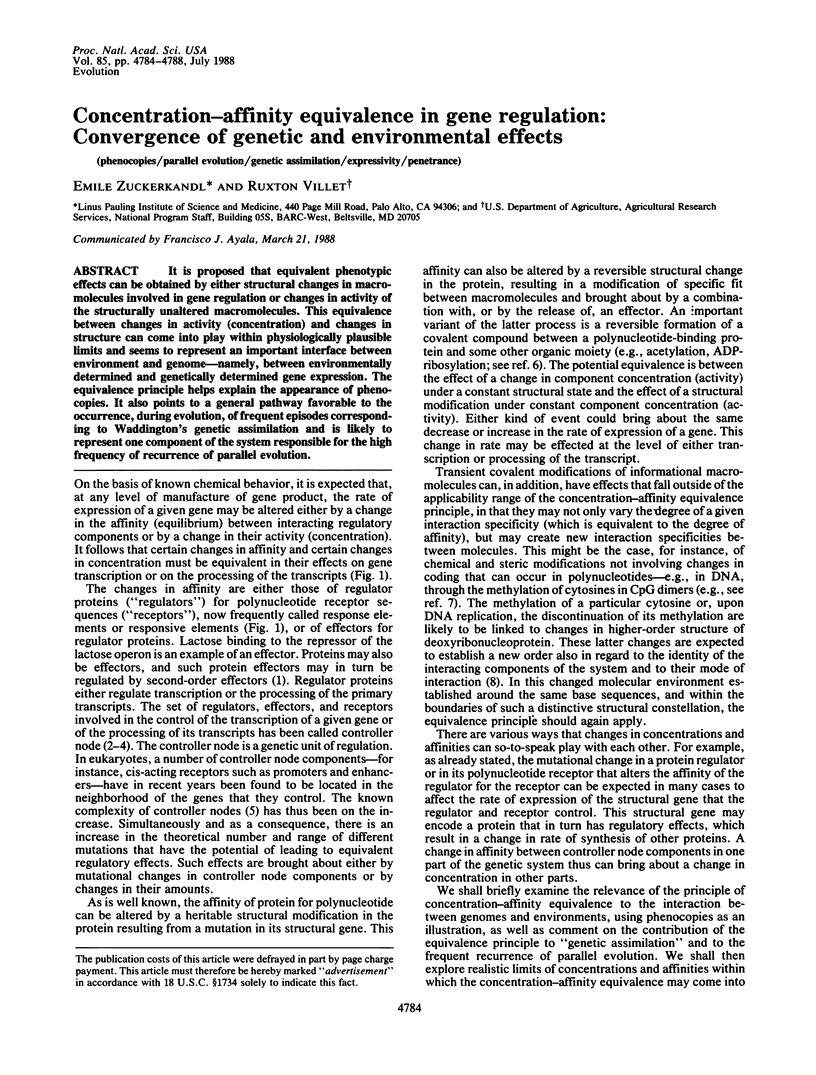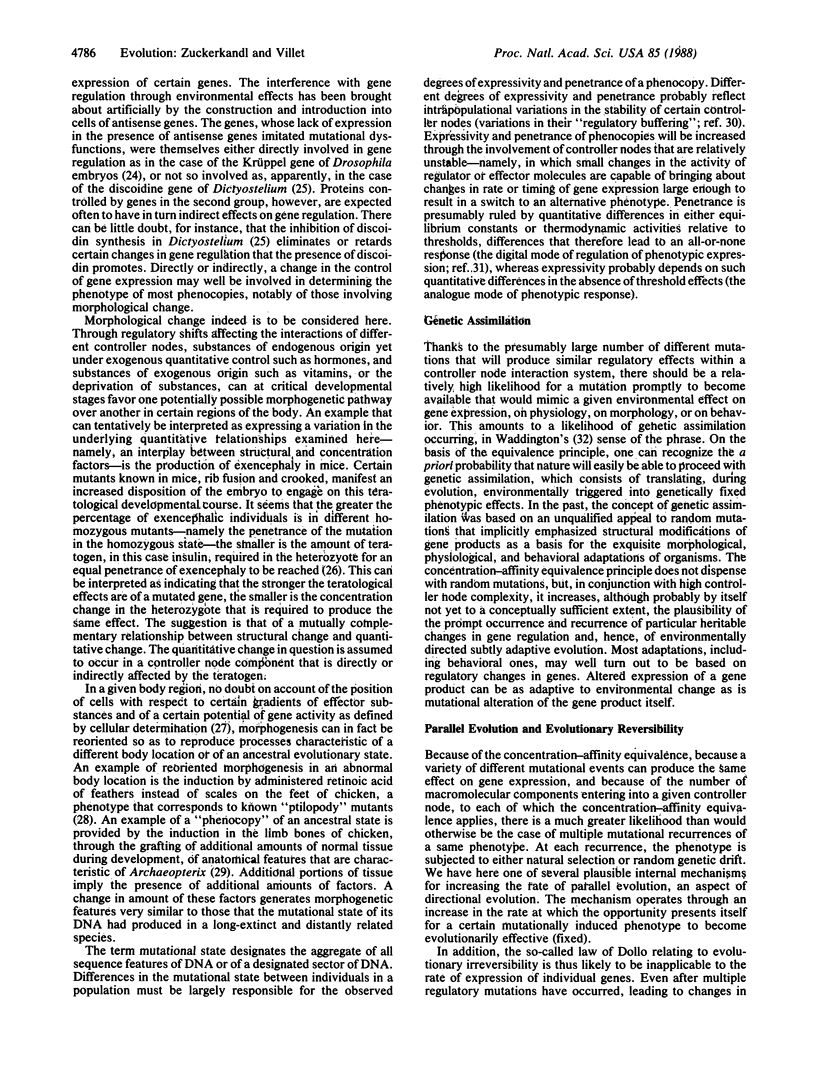Abstract
It is proposed that equivalent phenotypic effects can be obtained by either structural changes in macromolecules involved in gene regulation or changes in activity of the structurally unaltered macromolecules. This equivalence between changes in activity (concentration) and changes in structure can come into play within physiologically plausible limits and seems to represent an important interface between environment and genome--namely, between environmentally determined and genetically determined gene expression. The equivalence principle helps explain the appearance of phenocopies. It also points to a general pathway favorable to the occurrence, during evolution, of frequent episodes corresponding to Waddington's genetic assimilation and is likely to represent one component of the system responsible for the high frequency of recurrence of parallel evolution.
Full text
PDF




Images in this article
Selected References
These references are in PubMed. This may not be the complete list of references from this article.
- Angel P., Imagawa M., Chiu R., Stein B., Imbra R. J., Rahmsdorf H. J., Jonat C., Herrlich P., Karin M. Phorbol ester-inducible genes contain a common cis element recognized by a TPA-modulated trans-acting factor. Cell. 1987 Jun 19;49(6):729–739. doi: 10.1016/0092-8674(87)90611-8. [DOI] [PubMed] [Google Scholar]
- Betz J. L., Sadler J. R. Tight-binding repressors of the lactose operon. J Mol Biol. 1976 Aug 5;105(2):293–319. doi: 10.1016/0022-2836(76)90113-3. [DOI] [PubMed] [Google Scholar]
- Brown D. D., Schlissel M. S. A positive transcription factor controls the differential expression of two 5S RNA genes. Cell. 1985 Oct;42(3):759–767. doi: 10.1016/0092-8674(85)90272-7. [DOI] [PubMed] [Google Scholar]
- Bullock L. P., Watson G., Paigen K. Weak androgen reduces the rate constant of beta-glucuronidase induction. Mol Cell Endocrinol. 1985 Jul;41(2-3):179–185. doi: 10.1016/0303-7207(85)90021-8. [DOI] [PubMed] [Google Scholar]
- Butler A. P., Revzin A., von Hippel P. H. Molecular parameters characterizing the interaction of Escherichia coli lac repressor with non-operator DNA and inducer. Biochemistry. 1977 Nov 1;16(22):4757–4768. doi: 10.1021/bi00641a001. [DOI] [PubMed] [Google Scholar]
- Cole W. A., Trasler D. G. Gene-teratogen interaction in insulin-induced mouse exencephaly. Teratology. 1980 Aug;22(1):125–139. doi: 10.1002/tera.1420220115. [DOI] [PubMed] [Google Scholar]
- Crowley T. E., Nellen W., Gomer R. H., Firtel R. A. Phenocopy of discoidin I-minus mutants by antisense transformation in Dictyostelium. Cell. 1985 Dec;43(3 Pt 2):633–641. doi: 10.1016/0092-8674(85)90235-1. [DOI] [PubMed] [Google Scholar]
- Dhouailly D., Hardy M. H., Sengel P. Formation of feathers on chick foot scales: a stage-dependent morphogenetic response to retinoic acid. J Embryol Exp Morphol. 1980 Aug;58:63–78. [PubMed] [Google Scholar]
- Friedman B. E., Olson J. S., Matthews K. S. Kinetic studies of inducer binding to lactose repressor protein. J Biol Chem. 1976 Feb 25;251(4):1171–1174. [PubMed] [Google Scholar]
- GOLDSCHMIDT R. B., PITERNICK L. K. The genetic background of chemically induced phenocopies in Drosophila. J Exp Zool. 1957 Jun;135(1):127–202. doi: 10.1002/jez.1401350110. [DOI] [PubMed] [Google Scholar]
- HAMPE A. [Contribution to the study of the development and the regulation of deficiencies and excesses in the feet of chick embryos]. Arch Anat Microsc Morphol Exp. 1959 Jul-Dec;48:345–478. [PubMed] [Google Scholar]
- Johnston S. A., Salmeron J. M., Jr, Dincher S. S. Interaction of positive and negative regulatory proteins in the galactose regulon of yeast. Cell. 1987 Jul 3;50(1):143–146. doi: 10.1016/0092-8674(87)90671-4. [DOI] [PubMed] [Google Scholar]
- Jones K. A., Kadonaga J. T., Rosenfeld P. J., Kelly T. J., Tjian R. A cellular DNA-binding protein that activates eukaryotic transcription and DNA replication. Cell. 1987 Jan 16;48(1):79–89. doi: 10.1016/0092-8674(87)90358-8. [DOI] [PubMed] [Google Scholar]
- Keller E. C., Jr, Glassman E. Phenocopies of the ma-1 and ry mutants of Drosophila melanogaster: inhibition in vivo of xanthine dehydrogenase by 4-hydroxypyrazolo(3,4-d)pyrimidine. Nature. 1965 Oct 9;208(5006):202–203. doi: 10.1038/208202a0. [DOI] [PubMed] [Google Scholar]
- Kettler M. K., Whitt G. S. An apparent progressive and recurrent evolutionary restriction in tissue expression of a gene, the lactate dehydrogenase-C gene, within a family of bony fish (Salmoniformes: Umbridae) J Mol Evol. 1986;23(2):95–107. doi: 10.1007/BF02099903. [DOI] [PubMed] [Google Scholar]
- Lenz W. Phenocopies. J Med Genet. 1973 Mar;10(1):34–49. doi: 10.1136/jmg.10.1.34. [DOI] [PMC free article] [PubMed] [Google Scholar]
- Mitchell H. K., Lipps L. S. Heat shock and phenocopy induction in Drosophila. Cell. 1978 Nov;15(3):907–918. doi: 10.1016/0092-8674(78)90275-1. [DOI] [PubMed] [Google Scholar]
- Mitchell H. K., Petersen N. S. Gradients of differentiation in wild-type and bithorax mutants of Drosophila. Dev Biol. 1983 Feb;95(2):459–467. doi: 10.1016/0012-1606(83)90047-7. [DOI] [PubMed] [Google Scholar]
- Ohshima Y., Mizokoshi T., Horiuchi T. Binding of an inducer to the lac repressor. J Mol Biol. 1974 Oct 15;89(1):127–136. doi: 10.1016/0022-2836(74)90166-1. [DOI] [PubMed] [Google Scholar]
- Revzin A., von Hippel P. H. Direct measurement of association constants for the binding of Escherichia coli lac repressor to non-operator DNA. Biochemistry. 1977 Nov 1;16(22):4769–4776. doi: 10.1021/bi00641a002. [DOI] [PubMed] [Google Scholar]
- Rosenberg U. B., Preiss A., Seifert E., Jäckle H., Knipple D. C. Production of phenocopies by Krüppel antisense RNA injection into Drosophila embryos. Nature. 1985 Feb 21;313(6004):703–706. doi: 10.1038/313703a0. [DOI] [PubMed] [Google Scholar]
- Zuckerkandl E. Controller node complexity: a measure of the degree of gene coordination. J Mol Evol. 1979 Dec;14(4):311–321. doi: 10.1007/BF01732498. [DOI] [PubMed] [Google Scholar]
- Zuckerkandl E. Molecular evolution as a pathway to man. Z Morphol Anthropol. 1978;69(2):117–142. [PubMed] [Google Scholar]
- Zuckerkandl E. Multilocus enzymes, gene regulation, and genetic sufficiency. J Mol Evol. 1978 Oct 27;12(1):57–89. doi: 10.1007/BF01732545. [DOI] [PubMed] [Google Scholar]
- Zuckerkandl E., Villet R. Generation of high specificity of effect through low-specificity binding of proteins to DNA. FEBS Lett. 1988 Apr 25;231(2):291–298. doi: 10.1016/0014-5793(88)80836-6. [DOI] [PubMed] [Google Scholar]






